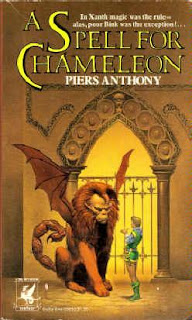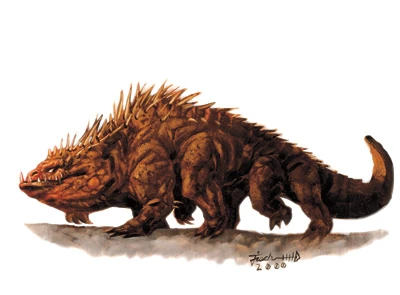Cockatrice Colophon!!
The question, though, is "What the hell kind of critter is this?"
For a while, I was thinking basilisk. That's mostly because of A Spell for Chameleon, which features a basilisk -- a rare enough creature in fantasy that I thought Anthony's book might have actually inspired the colophon. (Similarly, I suspect that Peter S. Beagle's The Last Unicorn inspired the Unicorn's Head colophon, but there's no knowing for sure.) Then I asked Douglas Anderson, who's pretty savvy with this sort of thing. He's always heard it called a gryphon colophon -- which is odd, since griffins are four-legged beasties, and this critter has only two.
Then he suggested it might be a cockatrice -- and, wouldn't you know it, I think he may be right.
In Anthony's novel, at least, basilisks and cockatrices seem to be equivalent creatures. Spell: "Cockatrice and basilisk -- two names for the same thing: a winged reptile hatched from a yolkless egg laid by a rooster and hatched by a toad in the warmth of a dungheap" (185). And here's the physical description: "A basilisk ... is just a small winged lizard, you know, with the head and claws of a chicken" (41). That certainly seems to be what's in the colophon.
But then I was checking out some images from D&D monster manuals, and here, respectively, are their basilisk and cockatrice.

With all due respect to artistic variation between D&D editions, their cockatrice looks much more like a "dragon-chicken" than the basilisk. Also, other than Anthony's book, I did find a more noteworthy instance of a cocktrice in fantasy -- Eddison's The Worm Ourobouros:
Therewith came forth that offspring of perdition from its hole, strutting erect on its two legs that were the legs of a cock; and a cock's head it had, with rosy comb and wattles, but the face of it like no fowl's face of middle-earth but rather a gorgon's out of Hell. Black shining feathers grew on its neck, but the body of it was the body of a dragon with scales that glittered in the rays of the candles, and a scaly crest stood on its back; and its wings were like bats' wings, and its tail the tail of an aspick with a sting in the end thereof, and from its beak its forked tongue flickered venomously. And the stature of the thing was a little above a cubit.
So, the colophon definitely seems to be a cockatrice.
Intriguingly, it looks like Ballantine/Del Rey were pretty haphazard in their use of this colophon. A number of their 1977 titles have it, like some Fletcher Pratt fantasies, but weirdly enough not The Sword of Shannara. Why not? Who knows, especially since the 1978 reprinting of Donaldson's Lord Foul's Bane has it. Likewise, the 1977 printing of Dunsany's The King of Elfland's Daughter has the colophon, but that was under the Ballantine imprint rather than Ballantine/Del Rey, so isn't even distinguishing del Rey's new editorship.
And then there's the curious case of Katherine Kurtz's Dernyi Checkmate (1972), an original BAFS novel. In the BAFS, of course, it has the Unicorn's Head colophon. The 1974 and 1976 Ballantine reprintings remove the colophon, but a colophon (the cockatrice one) reappears in the novel's 1977 reprinting under Ballantine/Del Rey. Dernyi Checkmate then kept the cockatrice colophon until its 1985 reprinting, at which point the publisher drops it again.
So, the usage of the cockatrice colophon seems inconsistent at best. Yet a better question is, "Why use a cockatrice at all?" It's not like cockatrices have any wide cultural cachet. They're oddball little creatures, and I have no idea what Ballantine/Del Rey's marketing department was hoping to accomplish with them.
--------------------
EDIT: Ah, I see now that Terri Windling's summation of fantasy for The Year's Best Fantasy and Horror (1990) also talked about the Del Rey Fantasy imprint as having a "Gryphon logo" (p. x). So




Comments
Post a Comment